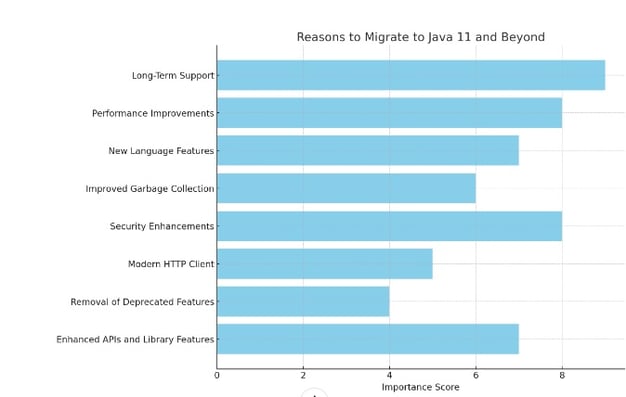How is migration to Java 11 and beyond essential for modernizing your software applications?
Imagine you're driving a reliable, well-loved car that's seen better days—its engine still purrs, but newer models on the road promise better fuel efficiency, advanced safety features, and a smoother ride. This scenario mirrors the journey of many developers and organizations still running on older versions of Java, such as Java 8.
Migrating to Java 11 and beyond is akin to upgrading to that newer car model, offering a suite of enhancements that boost the performance, security, and maintainability of applications. With Java 11, you're not just getting an update; you're embracing a platform that's been refined and optimized for today's digital challenges. Hire Java developer's to ensure your software runs more efficiently and securely and is future-proofed in the ever-evolving tech landscape.
Migrating to Java 11 and beyond is a strategic decision offering numerous benefits for businesses and developers. As newer versions of Java are released, they introduce many features, performance improvements, and security enhancements that make the migration process worthwhile and essential for staying competitive in today's rapidly evolving technological landscape.
Popularity of New Java Versions
According to the latest stats, Java adoption has seen a significant shift, with Java 11 leading at over 56% usage in production, closely followed by Java 8 at nearly 33%. Java 17's adoption has surged by 430% within a year, with over 9% of applications now using it in production, showcasing a rapid acceptance rate compared to Java 11. Conversely, Java 7 usage has dwindled to just 0.28%, mainly in legacy applications, following the end of its support in 2022. This reflects a dynamic evolution in the Java ecosystem, with developers increasingly leaning towards newer, more secure, and efficient application versions.
Key Reasons for Migration to Java 11 and Beyond
Migration to Java 11 and later versions is driven by several compelling reasons, including but not limited to:

- #1. Long-Term Support (LTS): Java 11 is an LTS release, ensuring long-term stability and support for applications, which is crucial for enterprise environments.
- #2. Performance Improvements: Enhancements in Java 11 and later versions improve application performance, including optimizations in the JVM.
- New Language Features: Introducing new language features like var for local variable type inference (introduced in Java 10), enhances code readability and reduces boilerplate.
- #3. Improved Garbage Collection: Java 11 introduces improvements in garbage collection mechanisms (like the Z Garbage Collector (ZGC) and Shenandoah GC) that reduce pause times.
- #4. Security Enhancements: Ongoing security updates and enhancements make Java 11 and beyond more secure against evolving threats.
- #5. Modern HTTP Client (Java 11): The introduction of a new HTTP Client API supports HTTP/2 and WebSocket, facilitating the development of modern network applications.
- #6. Removal of Deprecated Features: Cleaning up deprecated APIs and features (such as the removal of JavaFX from the JDK) makes the platform leaner and more efficient.
- #7. Enhanced APIs and Library Features: New APIs and library improvements make Java more powerful and versatile for developers.
The bar graph above visually represents the reasons to migrate to Java 11 and beyond, with a hypothetical importance score assigned to each reason. This visualization helps in understanding the relative importance of each factor that motivates the migration to Java 11 and later versions.
Analysing Migration to Java 11 And Beyond
Migrating to Java 11 and beyond involves several considerations and options, depending on the specific context of the existing Java applications, the organization's requirements, and the desired outcomes of the migration process. Here are some critical migration possibilities to Java 11 and beyond:
- Direct Upgrade:
This involves upgrading existing Java applications directly to Java 11 or later. It requires assessing the compatibility of the existing codebase with the target Java version, resolving any deprecated APIs or language features, and ensuring that third-party dependencies and libraries are compatible with the new version.
Direct upgrade is suitable for relatively recent applications that have been developed using modern Java features, making them compatible with Java 11 without significant modifications.
- Incremental Migration:
Incremental migration involves migrating the existing Java applications to Java 11 in stages rather than upgrading all components simultaneously. This approach allows for a gradual transition, minimizing disruptions and enabling developers to address compatibility issues and refactor code incrementally.
Organizations can prioritize critical components or modules for migration, followed by less critical ones, ensuring a smooth and controlled transition to Java 11 and beyond.
- Hybrid Approach:
A hybrid approach combines elements of direct upgrade and incremental migration, allowing companies to leverage the benefits of each approach based on their specific requirements. For example, critical components of the application may undergo a direct upgrade to Java 11, while less critical components are migrated incrementally.
This approach offers flexibility and allows organizations to tailor the migration process to suit the complexity and scale of their Java applications.
- Re-Platforming or Re-Engineering:
In some cases, organizations may opt for re-platforming or re-engineering their existing Java applications to take advantage of modern cloud-native architectures, microservices, or containerization platforms while migrating to Java 11.
Re-platforming involves migrating the application to a new platform or infrastructure, such as containers or Kubernetes. In contrast, re-engineering involves redesigning and refactoring the application to modernize its architecture and align it with contemporary best practices.
While re-platforming or re-engineering can offer significant benefits in scalability, agility, and resilience, but they require more extensive changes. They may involve higher costs and longer timelines than traditional migration approaches.
- Containerization:
Containerization involves packaging the existing Java applications into containers, such as Docker containers, and deploying them on container orchestration platforms like Kubernetes. This approach facilitates portability, scalability, and easier management of Java applications across different environments.
Containerization allows organizations to migrate their Java applications to Java 11 and beyond while taking advantage of the benefits of containerization, such as isolation, resource efficiency, and rapid deployment.
- Cloud Migration:
Organizations may migrate their Java applications to cloud platforms, such as Amazon Web Services (AWS), Microsoft Azure, or Google Cloud Platform (GCP), while upgrading to Java 11 and beyond. Cloud migration offers scalability, flexibility, cost savings, access to managed services, and advanced cloud-native capabilities.
Cloud migration involves assessing the existing Java applications for cloud readiness, refactoring or re-architecting them as necessary, and deploying them on the cloud platform of choice, often leveraging Platform-as-a-Service (PaaS) or Infrastructure-as-a-Service (IaaS) offerings.
- Outsourcing or Partnering:
Organizations may choose to outsource the migration of their Java applications to external vendors or partner with specialized migration service providers with expertise in migrating applications to Java 11 and beyond. Outsourcing can help accelerate the migration process, mitigate risks, and leverage external experts' experience and domain knowledge.
When outsourcing or partnering, organizations should ensure clear communication, define specific goals and requirements, establish accountability, and conduct thorough due diligence to select the right migration partner.
- Automated Migration Tools:
Automated migration tools can streamline upgrading Java applications to Java 11 and beyond by automatically identifying and addressing compatibility issues, refactoring code, and generating migration reports. These tools can accelerate migration, reduce manual effort, and ensure consistency and accuracy.
Organizations can evaluate and leverage automated migration tools compatible with their existing codebase, development environment, and target Java version, supplementing manual efforts with automated solutions to expedite migration.
- Testing and Validation:
Regardless of the chosen migration approach, thorough testing and validation are essential to ensure the migrated Java applications' stability, performance, and compatibility. This involves conducting comprehensive unit, integration, regression, and performance tests to identify and address any issues or regressions introduced during the migration process.
Automated testing tools, continuous integration (CI) pipelines, and robust testing strategies can help organizations validate the migrated applications and ensure a smooth transition to Java 11 and beyond.
- Training and Skill Development:
Migrating to Java 11 and beyond may require upskilling or retraining developers and IT personnel to familiarize them with the new features, APIs, tools, and best practices introduced in the target Java version. Investing in training programs, workshops, and certifications can empower teams to effectively leverage the capabilities of Java 11 and optimize the migrated applications for performance, security, and maintainability.
Training and skill development initiatives should be tailored to the teams' specific needs and proficiency levels involved in the migration process, ensuring a smooth transition and maximizing the benefits of migrating to Java 11 and beyond.
Migrating from Older Versions of Java to 11 and Beyond
- Java 6 to Java 11 Migration: Migrating from Java 6 to Java 11 involves upgrading from an outdated, unsupported version to a modern, long-term support (LTS) release. This migration offers significant benefits such as improved performance, enhanced security, access to new language features, and long-term support, ensuring continued stability and compatibility with modern software ecosystems.
- Java 8 to Java 11 Migration: Transitioning from Java 8 to Java 11 involves upgrading from a widely adopted version to a newer LTS release. This migration brings performance improvements, security enhancements, compatibility with modern libraries and frameworks, and the ability to leverage new language features introduced in Java 9, 10, and 11, such as modules, var keyword, and HTTP/2 client.
- Java 11 to Java 17 Migration: Upgrading from Java 11 to Java 17 involves moving to a newer non-LTS release, which offers incremental improvements in performance, security, and language features. While not providing long-term support, Java 17 introduces features like sealed classes, pattern matching, and foreign function and memory API. Hire java developers to avail opportunities in Java 17 for improved code expressiveness and functionality.
- Java 11 to Java 21 Migration: Transitioning from Java 11 to Java 21 involves upgrading to the latest non-LTS release, providing the most recent enhancements and features. Java 21 introduces advancements in performance, security, and language capabilities, allowing developers to leverage the latest innovations in the Java ecosystem for enhanced productivity and application functionality.
Here's the updated table of Comparison:
|
Migration |
Java 6 to Java 11 |
Java 8 to Java 11 |
Java 11 to Java 17 |
Java 11 to Java 21 |
|
Starting Version |
Java 6 |
Java 8 |
Java 11 |
Java 11 |
|
Target Version |
Java 11 (LTS) |
Java 11 (LTS) |
Java 17 |
Java 21 |
|
Benefits |
Improved performance, enhanced security, new language features, long-term support |
Performance improvements, security enhancements, compatibility with modern libraries, new language features |
Incremental performance and security enhancements, new language features (e.g., sealed classes, pattern matching) |
Latest enhancements and features, improved productivity, latest language capabilities |
|
LTS Support |
Yes |
Yes |
No |
No |
|
Notable Features |
- |
Modules, var keyword, HTTP/2 client |
Sealed classes, pattern matching, foreign function and memory API |
Latest performance, security, and language advancements |
|
Use Cases |
Outdated applications requiring modernization, compliance needs |
Applications looking to leverage new language features, improve security, and performance |
Applications seeking incremental improvements without requiring LTS support |
Development teams wanting to adopt the latest Java enhancements and capabilities |
Conclusion:
In conclusion, migrating Java projects from older versions like Java 6 or 8 to newer releases such as Java 11, 17, or 21 is essential to guide businesses toward modernization, ensuring they stay competitive and compliant with evolving industry standards. Leveraging tools like Maven and Spring Boot facilitates the migration process, streamlining dependency management and seamlessly integrating modern features. However, migration may entail addressing compatibility issues and updating project configurations to align with the latest Java frameworks and APIs. With careful planning and the right tools, businesses can successfully navigate the migration journey with reliable Java development services and unlock the full potential of their Java projects in today's dynamic technology landscape.
Author







.jpg?width=740&height=148&name=Purple%20and%20White%20Gradient%20Minimalist%20Online%20Webinar%20Digital%20Marketing%20Reddit%20Banner%20(2).jpg)


